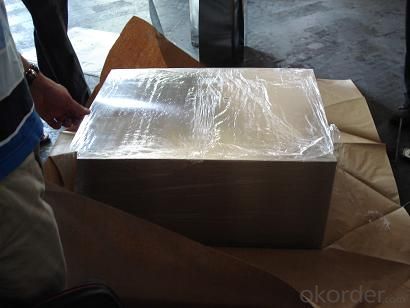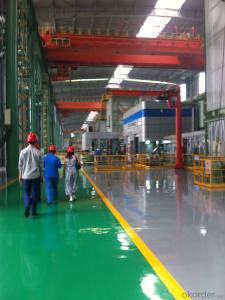Prime Quality Tinplate Sheets for 0.30mm
- Loading Port:
- Tianjin
- Payment Terms:
- TT OR LC
- Min Order Qty:
- 25 m.t.
- Supply Capability:
- 8000 m.t./month
OKorder Service Pledge
OKorder Financial Service
You Might Also Like
1.Structure Description
Electrolytic Tinplate Sheets is one of the metal packing materials, which is widely used for making painting cans ,chemical package cans , electrical cable ,battery and metal printing etc.
2. Main Features
Steady and high quality
Fast shipment
Good experience for export work
For the surface, Plate uniform in thickness,uniform and smooth tin coating, without flaws,rusts,scratch,wave,nick of tin coating etc.
Price competitive
3.Images

4. Specification
Standard : GB2520-2000 ,JIS G3303
Steel type : SPCC
Coating : 2.8/2.8
Surface: Bright, Stone ,
Thickness:0.26
Width :600MM~1000MM
Temper : T1~T5
Package: tinplate wrapped completely with an inner cover of plastic or waterproof papers with vorners protected with metal angels.
5.FAQ
A. What is the package of tinplate? (Referred as below)
For sheets, thin plastic film + rust-proof paper + metallic cover + metallic angles+ steel band strips + fumigated wooden pallet.
For coil, thin plastic film + rust proof paper + metallic cover + steel band strips + fumigated wooden pallet
B. The surface of tinplate could you supply?
Stone finish, Bright finish, Matte finish, Silver finish
C. What quantity is the minimum order of tinplate?
Usually, the minimum quantity is 25MT. For special case, consult with us.
D. Can it make to be BA or CA for annealing?
Yes, both can do with.
- Q:What are the advantages of using tinplate for packaging?
- Tinplate offers several advantages for packaging. Firstly, it provides excellent protection against moisture, air, light, and other external factors that could potentially damage the packaged goods. This ensures the preservation of quality and extends the shelf life of products. Secondly, tinplate is highly durable and resistant to corrosion, making it ideal for long-term storage and transportation. Additionally, tinplate is easily recyclable, making it an environmentally friendly choice. Lastly, tinplate provides a versatile and attractive packaging option, as it can be easily shaped and decorated, enhancing the visual appeal of the product.
- Q:How is tinplate coated to prevent corrosion?
- Tinplate is coated to prevent corrosion through a process called tinplating or electrolytic tin coating. In this process, a thin layer of tin is electroplated onto the surface of the tinplate. This tin layer acts as a protective barrier, preventing direct contact between the base metal (usually steel) and the corrosive elements in the environment, thus inhibiting corrosion.
- Q:What are the common applications of tinplate?
- Tinplate is commonly used for packaging food and beverages, such as cans for canned goods, metal caps for bottles, and metal containers for various products. It is also used for making aerosol cans, paint cans, and decorative tin boxes for storage purposes. Additionally, tinplate is used in the manufacturing of electronic components, automotive parts, and construction materials due to its corrosion resistance and durability.
- Q:How is tinplate coated with organic materials?
- Tinplate is typically coated with organic materials through a process called lacquering or varnishing. The organic coating, usually a resin-based material, is applied to the tinplate surface in a controlled manner, forming a protective layer that prevents corrosion, enhances durability, and provides a decorative finish.
- Q:What are the main challenges in tinplate canning process?
- The main challenges in tinplate canning process include ensuring proper sealing of cans to prevent leakage, maintaining consistency in can dimensions and shape, preventing contamination during the filling process, and ensuring efficient and cost-effective production while meeting quality standards. Additionally, addressing environmental concerns related to the disposal of tinplate waste and exploring alternative packaging materials are also significant challenges.
- Q:What are the cost considerations of using tinplate packaging?
- Some cost considerations of using tinplate packaging include the initial investment in machinery and equipment for production, the cost of sourcing and purchasing tinplate materials, and the expenses associated with manufacturing and assembly processes. Additionally, transportation costs may be higher due to the weight and volume of tinplate packaging compared to other materials. However, tinplate's durability and potential for recyclability can offer long-term cost savings and environmental benefits.
- Q:How is tinplate coated for construction materials?
- Tinplate is coated for construction materials through a process called electrolytic tin-plating. In this process, a thin layer of tin is applied to the surface of steel or iron sheets by immersing them in an electrolyte bath and passing an electric current through it. This creates a chemical reaction that deposits the tin onto the material, providing it with a protective coating against corrosion and improving its durability for construction purposes.
- Q:What are the advantages of using tinplate for paint cans?
- There are several advantages of using tinplate for paint cans. Firstly, tinplate is a highly durable material that provides excellent protection against corrosion and external elements, ensuring the longevity of the paint stored inside. Additionally, tinplate has a high resistance to impact, making it less likely to dent or get damaged during transportation or storage. Furthermore, tinplate has superior barrier properties, preventing the paint from interacting with oxygen or moisture, which could potentially affect its quality. Lastly, tinplate is a sustainable and recyclable material, making it an environmentally friendly choice for paint can packaging.
- Q:0.25mm which melting point is low in tin plate and tin plate?
- Tin plated steel sheet and strip, also known as tinplate, the steel plate (belt) surface tin plated, has good corrosion resistance, non-toxic, can be used as packaging material cans, inside and outside the cable sheath, telecommunications instrument parts, flashlight and other hardware.
- Q:Can tinplate be used for jewelry and accessories?
- Yes, tinplate can be used for jewelry and accessories. Tinplate is a versatile material that can be easily shaped, engraved, and decorated, making it suitable for creating various types of jewelry and accessories. It is durable, lightweight, and has a metallic appearance, making it an attractive choice for designers and consumers alike. Additionally, tinplate is affordable and readily available, making it a viable option for jewelry and accessory manufacturers.
1. Manufacturer Overview |
|
|---|---|
| Location | |
| Year Established | |
| Annual Output Value | |
| Main Markets | |
| Company Certifications | |
2. Manufacturer Certificates |
|
|---|---|
| a) Certification Name | |
| Range | |
| Reference | |
| Validity Period | |
3. Manufacturer Capability |
|
|---|---|
| a)Trade Capacity | |
| Nearest Port | |
| Export Percentage | |
| No.of Employees in Trade Department | |
| Language Spoken: | |
| b)Factory Information | |
| Factory Size: | |
| No. of Production Lines | |
| Contract Manufacturing | |
| Product Price Range | |
Send your message to us
Prime Quality Tinplate Sheets for 0.30mm
- Loading Port:
- Tianjin
- Payment Terms:
- TT OR LC
- Min Order Qty:
- 25 m.t.
- Supply Capability:
- 8000 m.t./month
OKorder Service Pledge
OKorder Financial Service
Similar products
New products
Hot products
Hot Searches
Related keywords



























